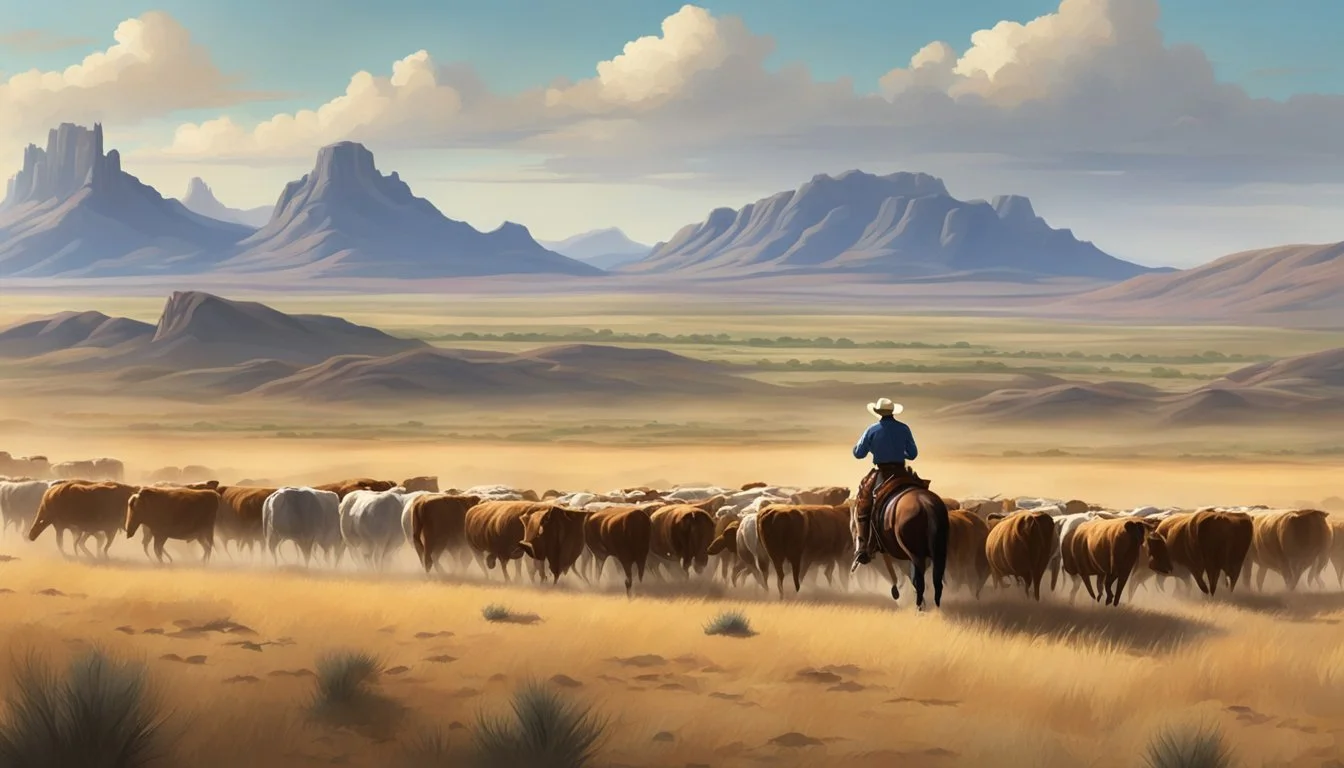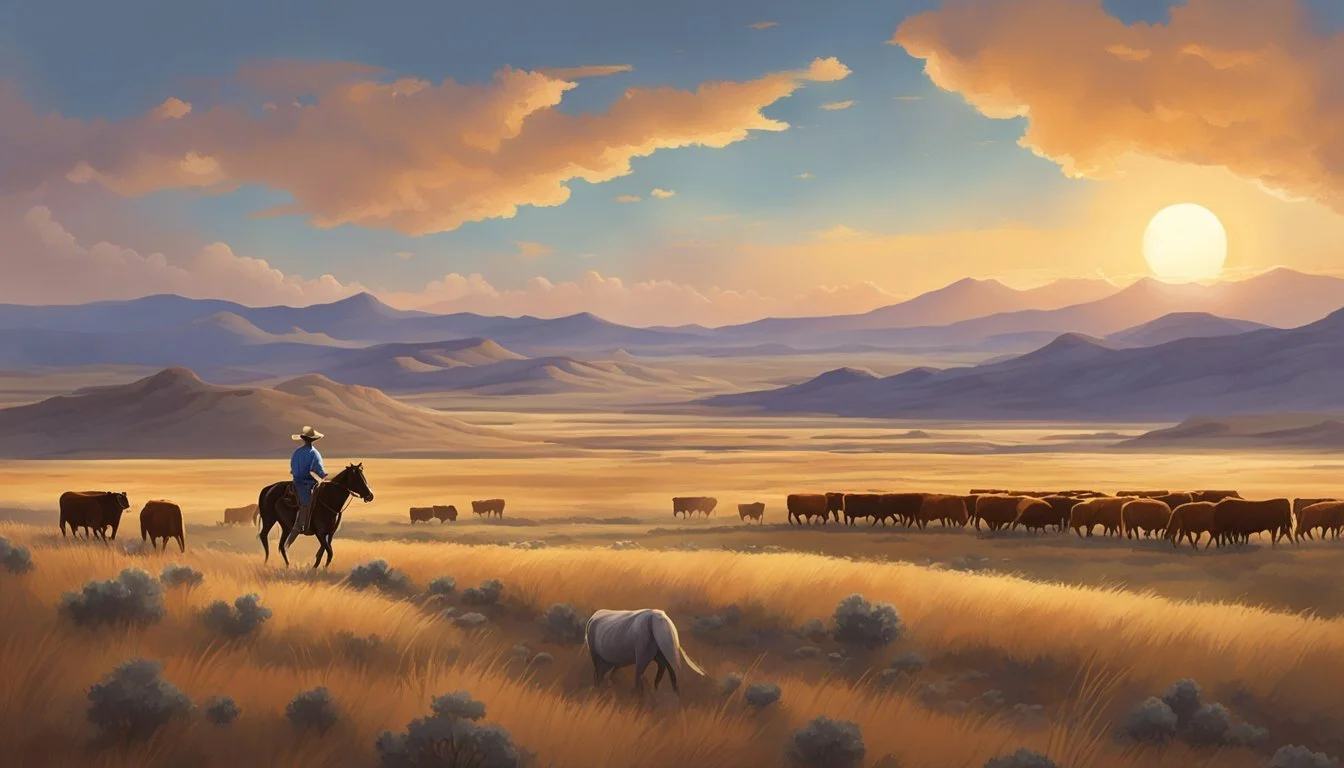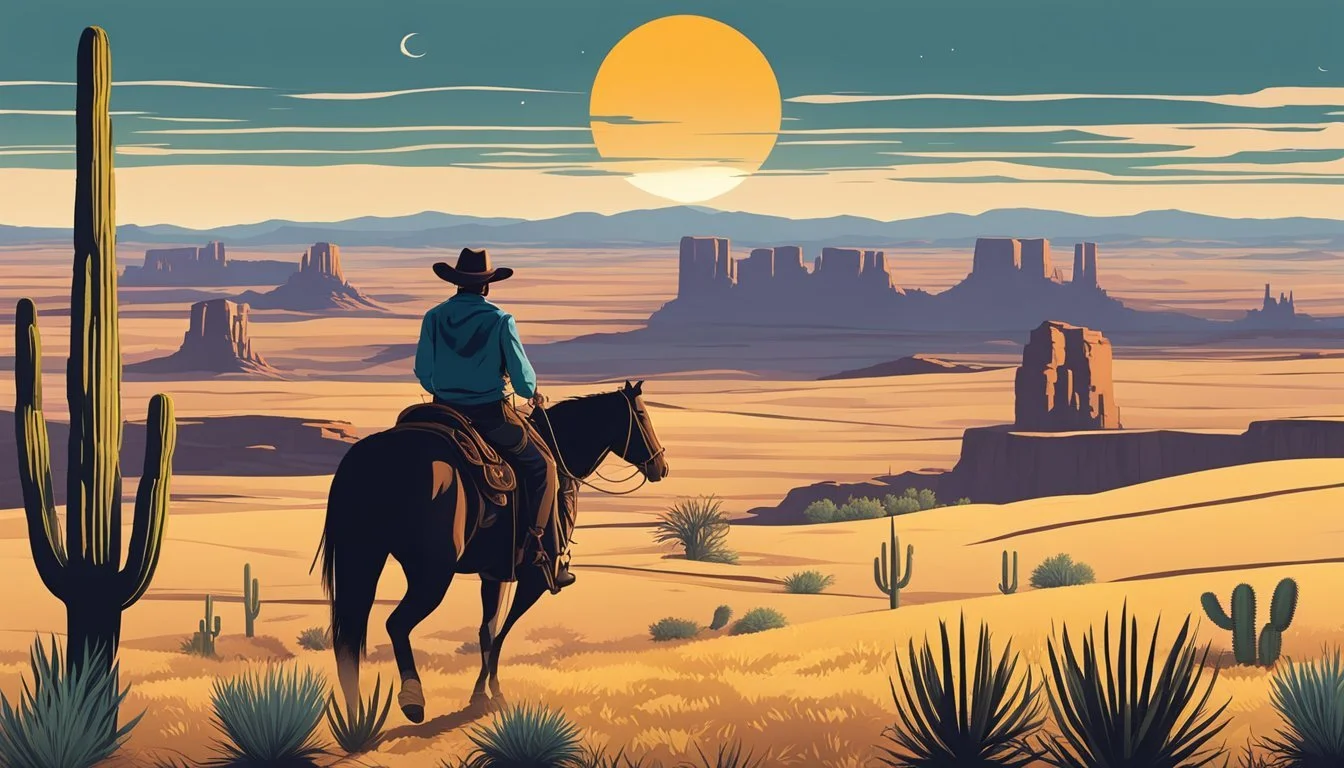The Texas Cowboy's Contribution to American Folklore
Unveiling the Legendary Roots
The Texas cowboy emerged during the post-Civil War era as a central figure in American folklore, embodying the spirit of the American West with a rich history steeped in tradition and culture. Adapted from the skills and customs of the Spanish Vaquero, cowboys in Texas became iconic for their distinctive dress and work practices, tending to cattle and shaping the ranching heritage that is celebrated in stories and legends across the nation.
These cowboys and their way of life have significantly influenced American folklore, giving rise to numerous tales, songs, and legends that reflect the values and experiences of life on the rugged frontier. Their stories, varying and evolving through time, are deeply woven into the fabric of American culture. The figure of the Texas cowboy has become emblematic of a larger narrative about the conquest of the wild, the taming of the frontier, and the values of independence and resilience.
Within the annals of Texas history, societies such as the Texas Folklore Society have played a pivotal role in collecting and preserving the state's rich stories and traditions since the early 20th century. As a result, the legacy of the Texas cowboy continues to capture the imagination, providing a vivid window into the customs and societal norms of a bygone era and an enduring symbol of American cultural identity.
Historical Origins of the Texas Cowboy
The Texas cowboy's origins are deeply rooted in international influences, the integration of various cultures, and the significant shifts of westward expansion. This rich tapestry shaped the iconic symbol of American independence and resourcefulness.
Influence of Spanish Vaqueros
The Spanish vaqueros set the foundation for the cowboy culture in Texas. They were skilled in herding and introduced their esteemed horsemanship to the region. The early vaquero practitioners were adept in cattle handling and ranch operations, setting standards that would evolve into the cowboy lifestyle known today.
African American and Mexican Contributions
Both African American and Mexican populations significantly shaped the cowboy heritage. African American cowboys, often overlooked in popular narratives, played a crucial role on Texas ranches, demonstrating their expertise in riding and roping. Similarly, Mexican vaqueros, originally influencing Texas from Spanish colonial times, continued to impart their traditions, meshing their techniques with the emerging cowboy culture.
Key Figures: African Americans like Nat Love became prominent cowboy figures, sharing their experiences and stories.
Migration and Westward Expansion
The allure of opportunity and the promise of land spurred westward expansion, amplifying the demand for Texas cowboys. As ranches expanded, so did the need for skilled labor to manage large herds of cattle.
Ranches Growth: The expansion led to the establishment of prominent ranches, like the King Ranch, pivotal in the cowboy's rise to legend.
Movement: Herding routes from Texas to northern markets became a critical element of economic and cultural exchange.
The Life and Work of Cowboys
The Texas cowboy is an icon of American folklore, known for his skills in cattle handling and horsemanship. His daily life was marked by hard work, facing the vast open range with resilience and determination.
Cattle Drives and Rodeos
Cattle drives were a defining element of a cowboy's work, involving transporting herds of cattle over long distances to market or new grazing grounds. Cowboys often drove up to 20,000 head of cattle yearly, navigating the perilous trails and weather conditions. Rodeos, meanwhile, emerged as competitive events showcasing a cowboy's riding, roping, and other ranch-related skills. These public contests became part of the legend, celebrating the cowboy's prowess and contributing to his storied image.
Horsemanship and Roping
Exceptional horsemanship was at the heart of a cowboy's skill set. Their proficiency in riding was critical not only for managing cattle but also for their own safety in difficult terrain. Roping, using a lasso to catch livestock, demanded precision and timing. Cowboys practiced this skill diligently, which later would become a celebrated part of rodeo events.
Daily Ranch Activities
A cowboy's day began at dawn, filled with a myriad of tasks essential for ranch operations. These included:
Tending to horses: Care, feeding, and preparation for daily activities.
Repairing structures: Fixing fences and maintaining ranch facilities.
Cattle management: Branding, herding, and ensuring the health of the herd.
General upkeep: Managing the land and resources to sustain the ranch long-term.
Open Range Challenges
The open range presented a host of challenges, from unpredictable weather to threats from outlaws and wildlife. Cowboys had to be vigilant and adaptable. They coped with limited water sources, navigated difficult terrains, and sometimes engaged in conflicts over grazing rights. Despite these hardships, they maintained the integrity of their cattle drives and upheld the legacy of the open range.
Symbols and Iconography
In the rich tapestry of American folklore, the Texas cowboy emerges as a vibrant symbol. The attire and gear of the cowboy have become iconic, transcending their practical origins to represent an entire way of life.
Attire and Gear
The attire of a Texas cowboy was designed for utility but has since become symbolic of the rugged individualism associated with the American West. Cowboy boots and chaps were distinctive elements of this attire. The boots, with high tops and heels designed for horseback riding, served the dual purpose of protection and support. Chaps, often made from leather, protected the cowboy's legs from the rough brush and elements.
Boots: Made for riding and work; high tops protect lower legs.
Chaps: Leather leg coverings; shield against the rough terrain.
The Cowboy Hat and Boots
The cowboy hat, originally inspired by designs like the Spanish sombrero, is perhaps the most recognizable symbol of this folklore. Its wide brim served as protection from the sun and rain, while the high crown allowed air circulation above the head. Each cowboy's hat was unique, molded by the hands of its owner to suit personal taste and functionality.
Wide brim for weather protection.
High crown for ventilation.
Cowboy boots have ascended from their practical beginnings into the realm of legend. Their pointed toes made it easier to slip into a stirrup, and the distinct stitching and materials have made them a statement piece far beyond their working origins.
Boots: Pointed toes for stirrup use; detailed stitching.
Cowboy Folklore and Legends
The cowboy's rugged image and frontier spirit have become deeply embedded in the fabric of American folklore and legends. This section explores the captivating stories of outlaws and marksmen, the vibrant ballads and songs that echo the cowboys' life, and the rise of dime novels that brought the cowboy mythos to readers across the nation.
Tales of Outlaws and Sharpshooters
The tales of outlaws and sharpshooters form a thrilling part of cowboy folklore. Characters such as Buffalo Bill and Annie Oakley are legendary, with their stories often blurring the lines between fact and fiction. Buffalo Bill, born William F. Cody, materialized through dime novels as a quintessential cowboy and frontiersman, while Annie Oakley, with her unrivaled marksmanship, became famously known as "Little Sure Shot."
Ballads and Songs
Cowboy ballads and songs are integral to folklore, encapsulating the hardships and daily life of the cowboy. They passed down the oral tradition, tales of cattle drives, and outlaws, with some, like "The Streets of Laredo," becoming emblematic of cowboy culture. These songs and ballads cemented the cowboy's place in American heritage, often culminating in gatherings around campfires or during trail drives where they were heartily sung.
Rise of Dime Novels
The rise of dime novels in the late 19th and early 20th century catapulted the cowboy into popular culture. These affordable and widely distributed publications sensationalized the wild American West, creating a voracious appetite for tales of lawmen, outlaws, and dynamic frontier life. Dime novels played a crucial role in shaping the mythos surrounding cowboys and the American West, delivering excitement and adventure to an eager audience.
Cultural and Artistic Influence
The Texas cowboy has left a distinct mark on various forms of American art and culture, influencing not just regional, but national artistic expressions across films, literature, music, and visual arts.
Hollywood and the Western Genre
Hollywood's portrayal of the Texas cowboy helped solidify the image of the rugged individualist, crucial to the mythos of the American West. Western films became a defining genre of American cinema, with cowboys as central characters embodying themes of bravery and freedom. Classic films like "High Noon" and "The Searchers" drew on the Texas cowboy archetype, shaping the genre for decades.
Key Figures:
John Wayne: A Hollywood icon who often played larger-than-life cowboy roles
Clint Eastwood: Known for his roles in Spaghetti Westerns like "The Good, the Bad and the Ugly"
Literature and Dramatic Arts
In literature, the cowboy hero became a staple of Western novels, reflecting the values and conflicts of frontier life. These narratives often portrayed cowboys in a romantic light, despite the harsh realities of their lives. Dramatic arts further explored these themes on stage, bringing stories of the West to audiences far removed from cowboy life.
Key Contributions:
Larry McMurtry's "Lonesome Dove": A Pulitzer Prize-winning novel depicting cowboy drives
Sam Shepard's plays: Which often explore the gritty underbelly of American myths
Music and Visual Arts
Cowboy music and visual arts also convey the Texas cowboy's impact, ranging from folk songs to country music, revealing the cowboy's lifestyle and the landscapes he roamed. Paintings and statues often romanticize the cowboy, while also capturing the essence of Western Americana.
Influential Genres and Artists:
Country Music: Artists like Willie Nelson have roots in cowboy culture through their music
Painting: Frederic Remington and Charles M. Russell, who vividly depicted cowboy life in their artwork
Modern-Day Legacy and Celebrations
The Texas cowboy remains a potent symbol in American folklore and continues to be celebrated through various contemporary festivals and academic studies that delve into the cultural significance of this iconic figure.
Festivals and Demonstrations
Among the numerous annual events honoring the Texas cowboy tradition, the Houston Livestock Show and Rodeo stands out. Known for its star-studded concerts and professional rodeo competitions, it also serves as a hub for showcasing cowboy skills with live demonstrations from working cattle handlers.
In the more intimate settings, smaller local festivals often feature ranching heritage demonstrations where visitors can witness cattle drives and intricate rope tricks first-hand, fostering a deeper appreciation for the cowboy's historical way of life.
Preservation and Folk Studies
Within the academic realm, institutions such as the Center for American History at the University of Texas meticulously document and preserve cowboy heritage. They approach the subject matter through anthropological and folklife studies, ensuring the modern business of ranching continues to be linked with its storied past.
Organizations like the American Folklife Center at the Library of Congress are pivotal in promoting understanding and appreciation of the cowboy's role in American culture through research and public presentations. These efforts highlight how modern folklore studies interpret the cowboy's contribution to American legends.
Sociocultural Impact
The Texas cowboy has become an indelible symbol of resilience and freedom, shaping the American identity and resonating globally.
American Identity and Symbols
The Texas cowboy emerged as a central figure in the mythology of the American West, encapsulating the rugged individualism and adventurous spirit associated with the Old West. Cowboys became the personification of the frontier ethos, influencing literature, film, and television. Their portrayal often includes iconic elements such as cattle drives and confrontations with the untamed wilderness, which are etched into the national consciousness. The cowboy has also manifested in physical symbols like the Stetson hat, spurs, and the cowboy boot—each becoming synonymous with American cultural ideals.
Influence on Global Cultures
The legend of the cowboy transcends American borders, casting a wide influence on global cultures. Western films and dime novels have propagated the cowboy archetype, spreading stories of the Wild West around the world. This fascination is evident in international adoption of western-themed apparel, festivals, and music. Moreover, the representation of the cowboy in international media reinforces the ideals of bravery, justice, and independence, often associated with the United States. The global impact is multidimensional—ranging from fashion to entertainment and even shaping perceptions of American values.






